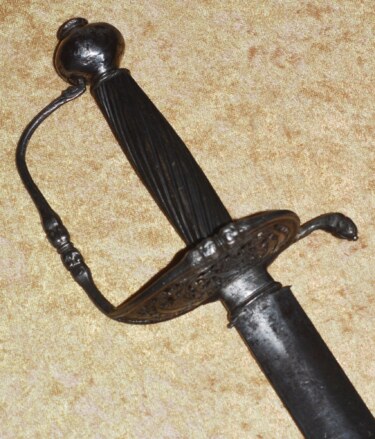Description
The plug bayonets of England had curved blades more often than any other country. This
example with curved single-edged unfullered 17 5/8″ blade of wedge section, the last 7″
double-edged; stamped with full-face king’s head mark on both sides (worn). Brass guard
with vertically recurved quillons and plain tapering cylindrical pommel attached to the dark
turned wood grip; brass base ferrule. Overall length 22 1/4″. A plug bayonet with nearly
identical blade and bearing the same maker’s mark is pictured in “The Plug Bayonet”, by
R.D.C. Evans, fig. 78.
Though probably originating around 1550, the plug bayonet had a relatively short span of
use from around 1650-1720 (except in Spain where they were used into the 19th C). Their
rise in popularity largely paralleled the development of standing armies in Europe, which
were realizing the importance of the musketeer, while at the same time not wanting to
wholly abandon the pike. In this sense the plug bayonet can be considered a transitional
weapon. However, despite its use as a dagger on its own, it was soon found to be
impractical since it’s use prevented the musket from being fired. Countless soldiers also
found great difficulties in removing a stuck plug bayonet from the muzzle, rendering the
musket useless as a firearm. Many were damaged while being removed and as a result
relatively few survive. For these reasons it was soon superseded by the socket bayonet,
which did not affect the musket’s ability to fire and could much more easily be removed.








 Late 17th C Officer’s Sword, French or German
Late 17th C Officer’s Sword, French or German  European Rapier, 17th C Style, ca. 1900
European Rapier, 17th C Style, ca. 1900  English Helmet-head Plug Bayonet, Last Quarter 17th C
English Helmet-head Plug Bayonet, Last Quarter 17th C  German Officer’s Broadsword with Scabbard, ca. 1680
German Officer’s Broadsword with Scabbard, ca. 1680